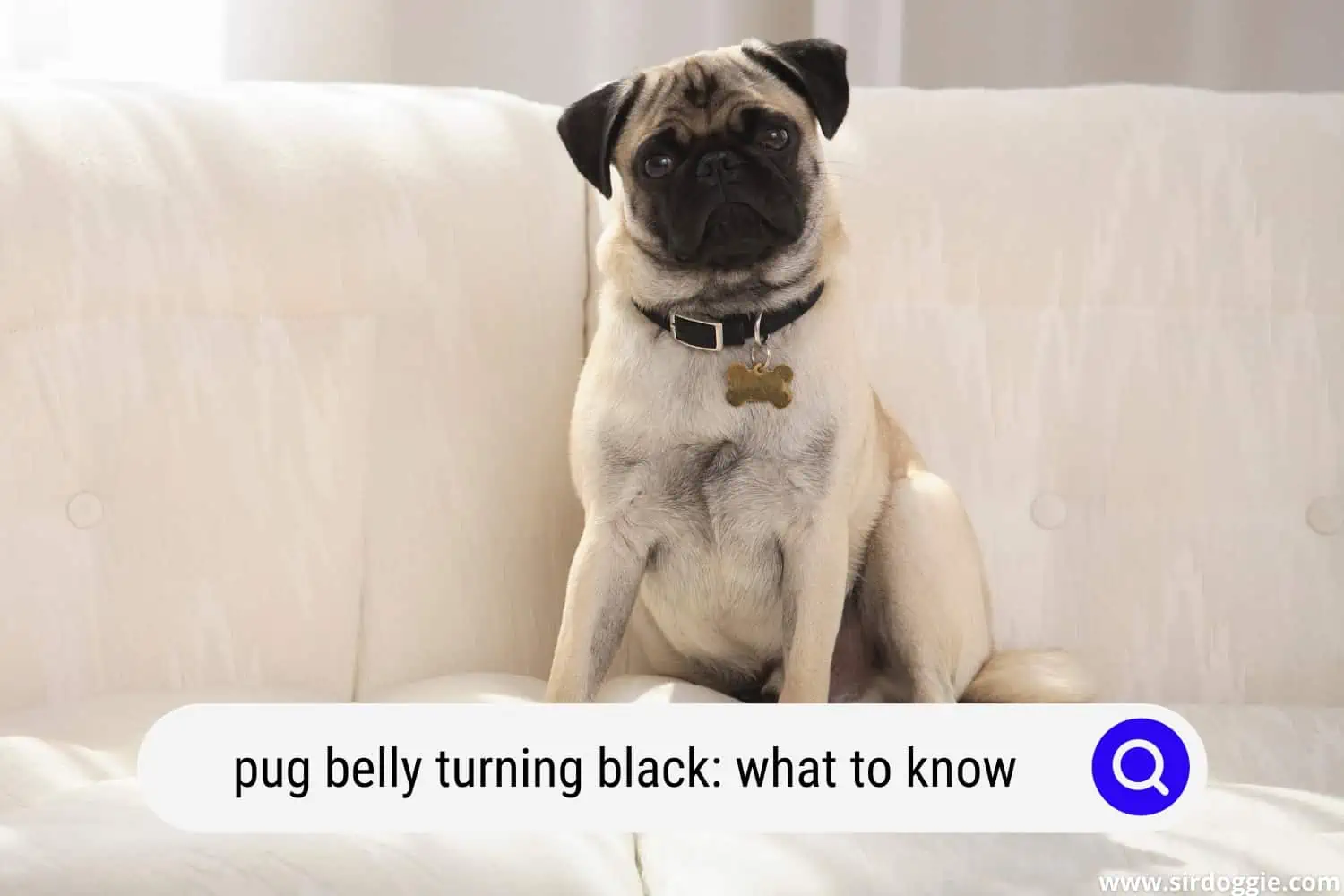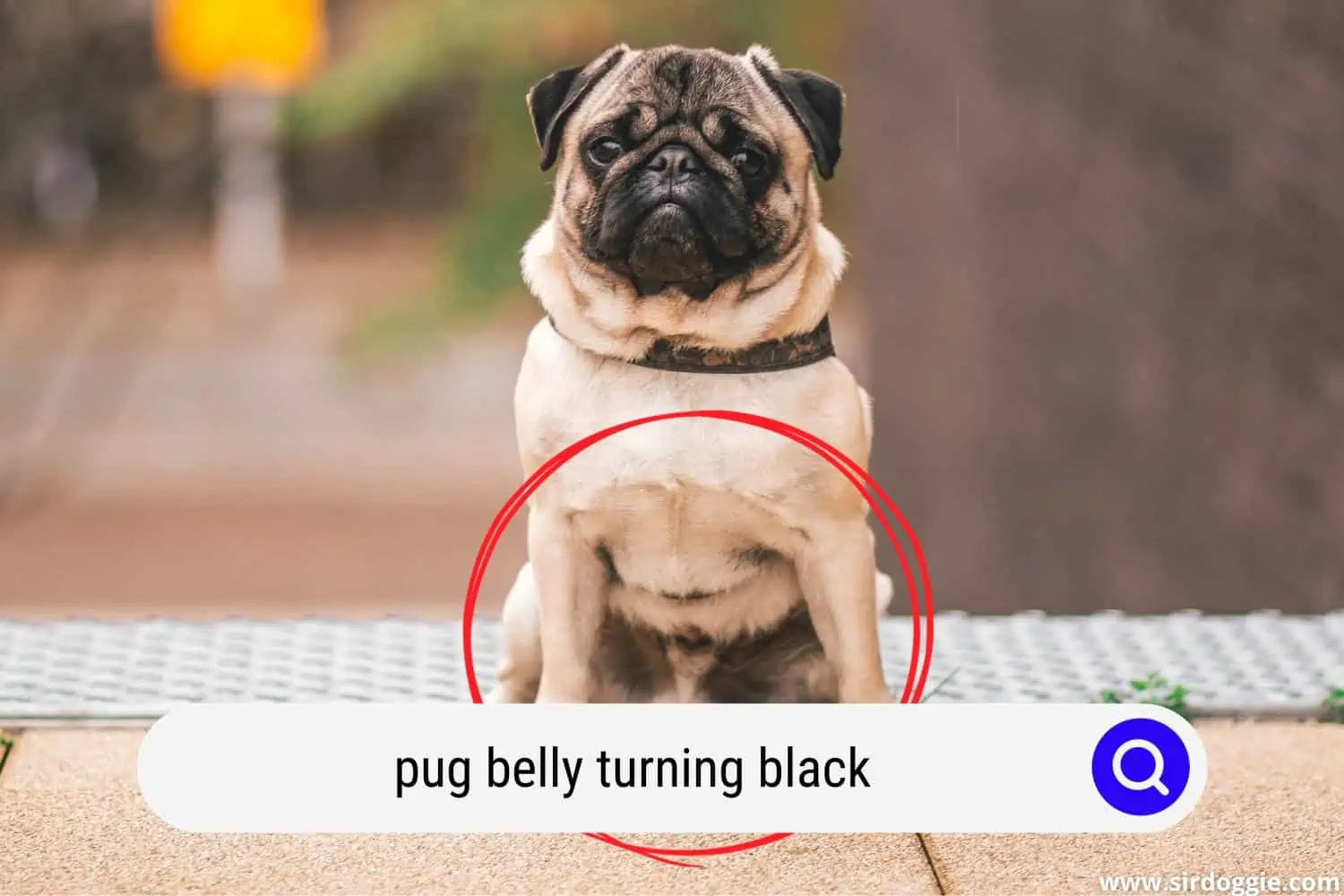Pug Belly Turning Black – Things You Need To Know
Turning your pug puppy over and seeing that its once-pink stomach starts to become black might be frightening, so you ask yourself why is my pug belly turning black? What may be the source of this? Is your dog in any discomfort?
This post is mainly about what are the most familiar reasons why your pug’s skin might become black.

Why Is My Dog Belly Turning Black?
There are a couple of reasons why your Pug’s belly is turning black, but the most common reason might be Hyperpigmentation, as well as allergies, skin infections, yeast infections, aging, etc. You might not know what this thing means, but you can read it below in this article.
While it’s normal for your mind to rush with anxiety and fear since you like your pug, this will do nothing to assist your dog in feeling better. Pugs are prone to skin issues, and that might be one of them. What will assist is to make an appointment with your dog’s veterinarian right away.
Your veterinarian will examine and test to rule out reasons and choose the best course of action. Let’s look at why your Pug’s skin is changing in more detail. If your Pug’s coat is black and he spends a lot of time outside, read this.
Hyperpigmentation In Dogs
The most common cause of a section of your dog’s skin darkening or turning black is hyperpigmentation, and too much pigment is what the term “hyperpigmentation” denotes.
According to veterinarians, hyperpigmentation is most frequent in dachshunds, although it can affect any breed. We are classifying hyperpigmentation mostly into two categories: primary stage and secondary stage.
Hyperpigmentation in primary stages
Primary hyperpigmentation is a more uncommon condition. An underlying hereditary condition is assumed to be the cause. Primary hyperpigmentation usually manifests itself by the time a dog reaches the age of one year. There is presently no cure, although tablets might help to treat it.
Hyperpigmentation in secondary stages
Secondary hyperpigmentation is far more prevalent in pug dogs, and it can appear at any age. Allergies, skin infections, contact dermatitis, hormone changes, and weight difficulties are more prone to cause secondary hyperpigmentation in dogs.
Inflammation from these and other disorders can cause a pug’s skin to develop excessive pigment. Other signs to look out for include:
- stench (not pleasant)
- Skin thickening and hair loss at or near the region of the discolored skin
- Symptoms of discomfort
- Redness
- Itching
- Infection of the fluid (discharge)
Secondary hyperpigmentation is usually treatable if treated aggressively. Medication is the best therapy. It is crucial to be patient because the treatment might take a long time (months) to work.
Hyperpigmentation treatment
Unfortunately, there is no effective treatment. However, as a Pug parent, you may use pharmaceutical shampoos and steroid ointments to help manage the symptoms.
If your Pug has secondary pigmentation, if the underlying condition is cured, their skin will revert to normal. You should also treat any bacterial, skin, or yeast infections that have developed because of hyperpigmentation.
Veterinarian visit
Consult your veterinarian if the hyperpigmentation symptoms persist. They will be able to conduct a comprehensive physical examination.
Although it might be hard to determine the reason for hyperpigmentation in dogs, your veterinarian is the best person to do so and can prescribe the best therapy.
Many of the symptoms of black skin hyperpigmentation are similar to those of other disorders including hypothyroidism and Cushing’s Disease. As a result, the most effective technique to make a diagnosis is elimination.
Skinfold pyoderma
Skin infections can occur in areas of a Pug’s body where there is loose skin or skin that folds over upon itself. The curl of the tail and the face are the most typical areas. There will be a noticeable, unpleasant odor, and the skin may seem red or inflamed.
Using hydrocortisone-containing wipes can assist with this. Bring your Pug to the vet for a medicated bath that rinses topical steroid cream for short-term treatment if the problem is significant. Using a tiny dose of benzoyl peroxide regularly can help prevent this sort of skin condition from recurring.
Aging
Another less well-known reason for a pug’s skin darkening is the natural aging process. If your pug’s skin went through some tests for skin disorders, and the findings have all been negative, and your pug appears to be in no pain, it might just be aging that is causing the skin to darken.
My Dog Skin Is Turning Black And Smells (Yeast Infection)
Because of their skin folds and floppy ears, they are prone to yeast infections. These locations are ideal for the yeast to hide and reproduce. If your dog’s skin suddenly becomes darker or black, it might be an indication of a yeast infection.
There’s a considerable probability you’ll detect a unique corn chip or cheese popcorn scent emanating from that location. Yeast infections may be quite painful for your pug, so it’s critical to treat them as soon as possible.
In addition to skin darkening or black skin, keep an eye out for the following signs and symptoms:
- Dogs with little black freckles, especially on the belly
- Scratching the ears or shaking its head
- Baldness in the tailbone or upper back
- Unpleasant scent
- Appetite loss (usually noticeable in a pug!)
- Tired and lethargy
- Foot licking or chewing, as well as darkened hair, are signs of diabetes.
- dirty fur
Also, if your dog’s symptoms seem to go in the winter and recur in the summer, it’s a clue that it’s suffering from yeast rather than basic allergies.
Treatment
If you suspect your Pug has a yeast infection, call your canine veterinarian so they can test him and determine for sure.
To improve your Pug’s skin, they’ll most likely give you medicated shampoo or antibiotics. This form of home remedy treatment is used twice a week and is usually enough to clear up the yeast infection.

Final Thoughts On Pug Belly Turning Black
Don’t be alarmed if your Pug’s skin has become black. Black skin condition is not threatening your pug’s health overall.
As we’ve covered, there are a couple of reasons that might be happening, and the problem is typically treatable with a balanced diet and using sunscreen on any exposed skin. If you still have problems with your pug belly turning black, the right thing to do is to see your veterinarian.
Your veterinarian will be able to determine the source of the problem and assist you in managing your Pug’s symptoms.
Related Reading: Why Is My Poodle’s Skin Turning Black?

Family Dog Expert Author
Hi there! I’m Stuart, a devoted dog lover and family dog expert with over a decade of experience working with our furry companions. My passion for dogs drives me to share my knowledge and expertise, helping families build strong, loving bonds with their four-legged friends. When I’m not writing for SirDoggie, you’ll find me hiking, playing with my beautiful dog, or studying music.